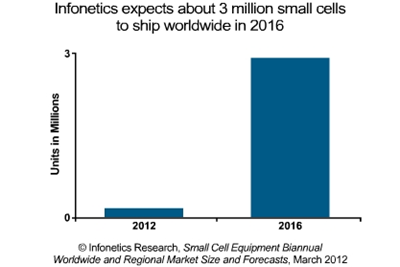Campbell, CALIFORNIA, 2012年3月27日-市場調査会社Infonetics Researchは本日、 Small Cell Equipment 市場規模と予測に関する最新レポートの概要を発表した。当該市場について最初のリリースである同レポートでは、microcells, picocells, そして femtocells (公共スペース、非住居区)として知られている低出力携帯ネットワークノードの文脈のなかでのsmall cellを対象としている。分析対象事業者は「ビッグ5」とよばれるRAN 事業者、すなわちAlcatel-Lucent, Ericsson, Huawei, Nokia Siemens Networks, ZTE、さらにsmall cell専業事業者である ip.access, Contela, Juni, Minieum Networks, Ubiquisys等である。

アナリストノート
「microcells や picocells を含むsmall cells は過去20年間、通話範囲改善のために使用されてきたが、現在では携帯ブロードバンドの問題意識はキャパシティ改善にシフトしている。」と、Infonetics Research で携帯インフラと事業者経済分析を担当している主席アナリストStephane Teralはコメントしている。「そのため事業者の主たる目的は、公共スペースでのfemtocells や WiFiなど低出力ノードの種類を増やしつつ、キャパシティの観点からmacrocell レイヤーを補完し拡充することである。しかしながら、マクロレイヤーをより小さいセルに分割するのは、セル間干渉やバックホール問題もあり困難である。問題は、セルはどの程度小さくできるかということである。なぜなら、セルが小さくなればなるほど、エリアをカバーする機器数が増えるからであり、それがsmall cell 市場の真の規模を決定することになる。」
主席アナリストでありInfonetics の共同設立者である Michael Howard の追加コメント。「当社のsmall cell 市場予測は絵に描いた餅でもなければ、各都市ブロックにおけるsmall cells の2020年における技術に対する見方に基づく「新技術に特有の楽観的な」予測でもない。当社の予測は、Infonetics内の複数のアナリストや調査チーム、携帯事業者、メーカー、半導体供給事業者との1年におよぶコラボレーションの成果である。予測に際しては、検証や議論を行ったほか、様々な機会を活用して主要な事業者にヒアリングを行った。そこで知ることができたのは、今日の事業環境、予算、small cell料金決定、規模および形態に関する基準、新たな技術問題、場所に密接に関係するpico・macrocell比率、small cellレイヤーの自動化、マクロレイヤーとの連携に関する事業者の考え方、計画、検証結果、試行錯誤である。これら全てをもとに、当社では彼らとともに今後数年間で実現されると思われる市場について詳細な調査を行ったのである。」
SMALL CELL市場のハイライト
- Infoneticsは世界的なsmall cell 市場は急成長すると予想しており、約3百万のsmall cells 機器が出荷され、市場規模は2016年に21億ドルになるとみている。
- 事業者が、飽和したmacrocellネットワークの拡充を目指すことによりSmall cell 市場の成長がもたらされる。macrocell は現在のところ、加入者向けの優れた携帯ブロードバンド利用を維持するのに難航している。
- 今後3年間程度、ほとんどの事業者は都市中心部のみでのsmall cell 導入を予定している。
- Infonetics では、2012年に公共スペースでのfemtocells が全small cell機器出荷の50%超を占めると予想している。
- 2013年、Infonetics は3G small cells が世界的なsmall cell出荷の63%を占めると予想しているほか、4G small cells はサービスが新たに開始され構成比も37%に急伸するとみている。
- 4G small cell の出荷数は2015年までに3G small cells を超えるだろう。
- 地理的な観点からみると、AT&T, Softbank, Vodafone といった初期のfemtocell 採用事業者およびマクロネットワークの密度は、どの地域にsmall cellの最大の成長機会があるかを示している。これによるとアジア太平洋は2012年に出荷される全ての機器の44%を占めて最大となっているほか、EMEA が32%でこれに続いている。
Infonetics' new biannual Small Cell Equipment report provides worldwide and regional market size, forecasts, and market analysis for 3G microcells, picocells, and public space femtocells (W-CDMA/HSPA and CDMA2000/EV-DO) and 4G (LTE) FDD and TDD mini eNodeBs and public space femtocells. The 22-page analysis report that accompanies the customizable Excel report includes in-depth analysis and data charts, a Mobile Operator Small Cell Strategies Tracker, Customer Wins and Service Provider and Vendor Announcements, and a Small Cell Specifications Comparison. Vendors whose small cell solutions are tracked in the report include Airvana, Airwalk, Alcatel-Lucent, BelAir, Cisco, Ericsson, Fujitsu, Huawei, ip.access Motorola, NEC, Nokia Siemens Networks, Samsung, Thomson, Ubiquisys, UTStarcom, ZTE, ZyXEL, and others.
RELATED RESEARCH
- Femtocell market set to double in 2012, Airvana expands lead
- Operators turn to femtocells to improve enterprise coverage and capacity
- Adoption of small cells / public space femtocells reflects a mobile world in transition
- Small cell survey shows operators plan to run 12% of network capacity on small cells by 2012
- New study details operator plans for small cell backhaul
- Femtocell operator survey provides glimpse into the future of femtocell services
Small cell market to hit 3 million units in 2016, driven by urban area capacity upgrades
Campbell, CALIFORNIA, March 27, 2012-Market research firm Infonetics Research today released excerpts from its new Small Cell Equipment market size and forecast report. The first-of-its-kind report tracks small cells in the context of low power mobile network nodes known as microcells, picocells, and femtocells (public space, not residential) made by the "Big 5" RAN vendors -- Alcatel-Lucent, Ericsson, Huawei, Nokia Siemens Networks, and ZTE - as well as small cell specialists like ip.access, Contela, Juni, Minieum Networks, Ubiquisys, and others.
ANALYST NOTE
"While small cells, including microcells and picocells, have been used for the past two decades to improve voice coverage, now mobile broadband is shifting the game to capacity upgrades," notes Stephane Teral, principal analyst for mobile infrastructure and carrier economics at Infonetics Research. "Therefore, the chief objective is to complement and enhance the macrocell layer from a capacity standpoint with a new breed of low-power nodes like public space femtocells and WiFi. But dividing the macro layers into smaller cells remains challenging due to inter-cell interference and backhaul issues. The question is: how small can the cell be? Because the smaller the cell, the higher the number of units required to cover an area, and that will determine the true size of the small cell market."
Principal analyst and Infonetics co-founder Michael Howard adds: "Our small cell forecast is not a pie-in-the-sky, new-technology-honeymoon forecast based on futuristic 2020 technology visions of small cells on every city block. We developed our forecasts after a solid year of work by several Infonetics analysts and our research team with mobile operators, manufacturers, and chip suppliers. We examined, discussed, challenged, and listened-often on multiple occasions-to the major footprint operators to learn about their thinking, planning, testing, and trialing across their realities of today's operations, budgets, target small cell pricing, sizing and form-factor requirements, emerging technology issues, location-sensitive pico-to-macrocell ratios, and small cell layer automation and coordination with the macro layer. And in all of this, we explored with them what they think is realistic over the next few years."
SMALL CELL MARKET HIGHLIGHTS
- Infonetics forecasts the global small cell market to grow rapidly, with about 3 million small cells shipping and the market worth about $2.1 billion in 2016
- Small cell market growth is being driven by operators seeking to enhance saturated macrocellular networks that are currently struggling to maintain a decent mobile broadband experience for subscribers
- For the next 3 years or so, most operators are planning small cells only in the urban core
- Infonetics expects public space femtocells to make up more than 50% of all small cells shipped in 2012
- In 2013, Infonetics expects 3G small cells to make up 63% of global small cell shipments, with 4G small cells kicking off and ramping up rapidly to make up 37%
- 4G small cell shipments will overtake 3G small cells by 2015
- From a geographic perspective, early femtocell adopters such as AT&T, Softbank, and Vodafone and macro network density dictate which regions represent the largest small cell opportunities, with Asia Pacific expected to lead with 44% of all units shipped in 2012, followed by EMEA with 32%

